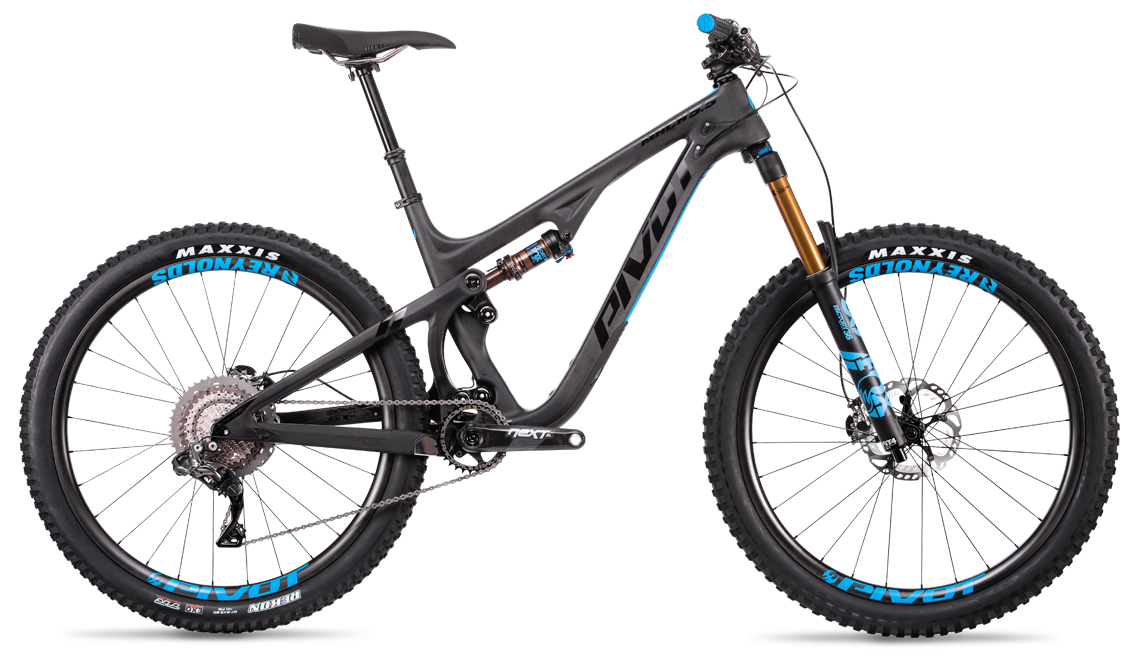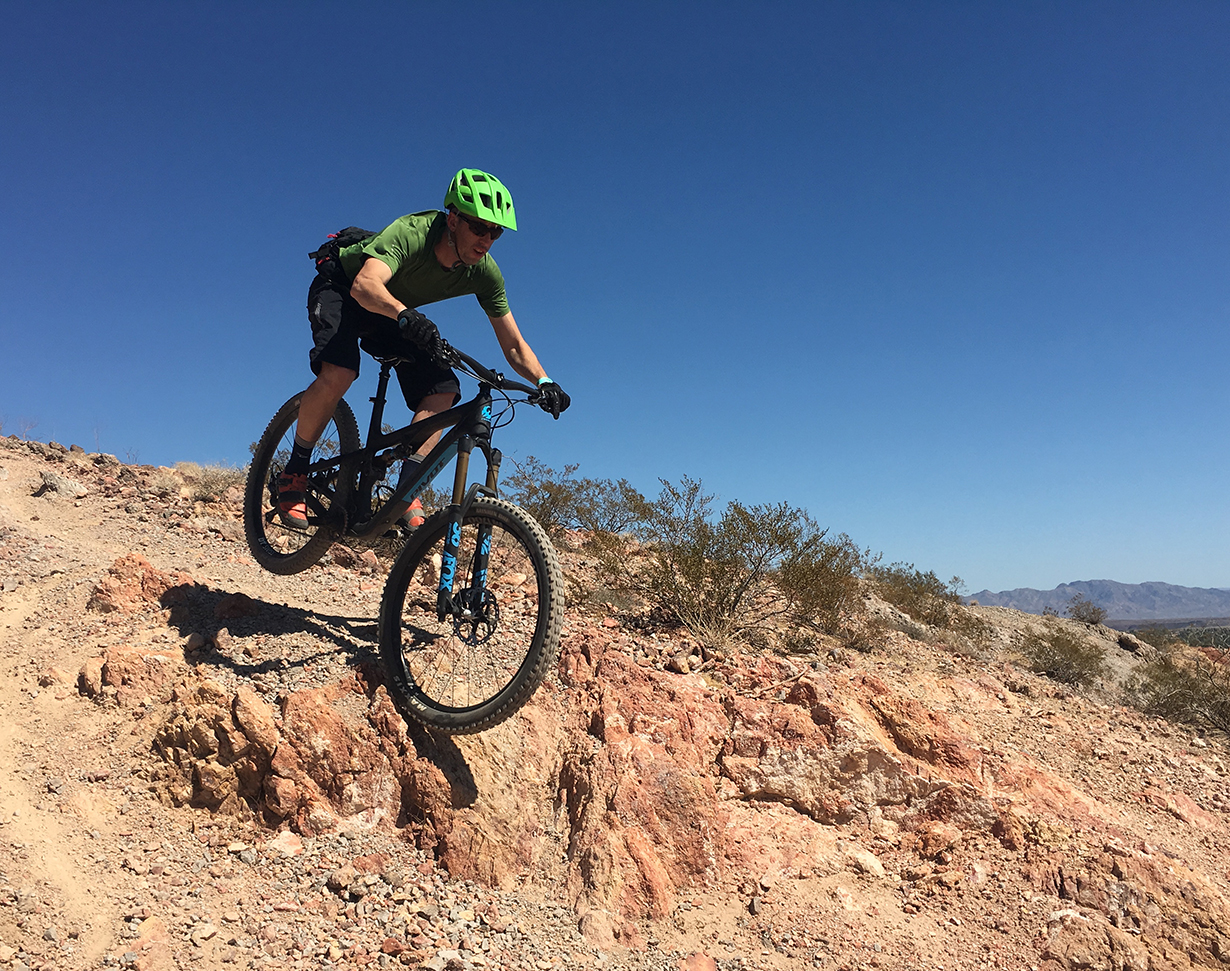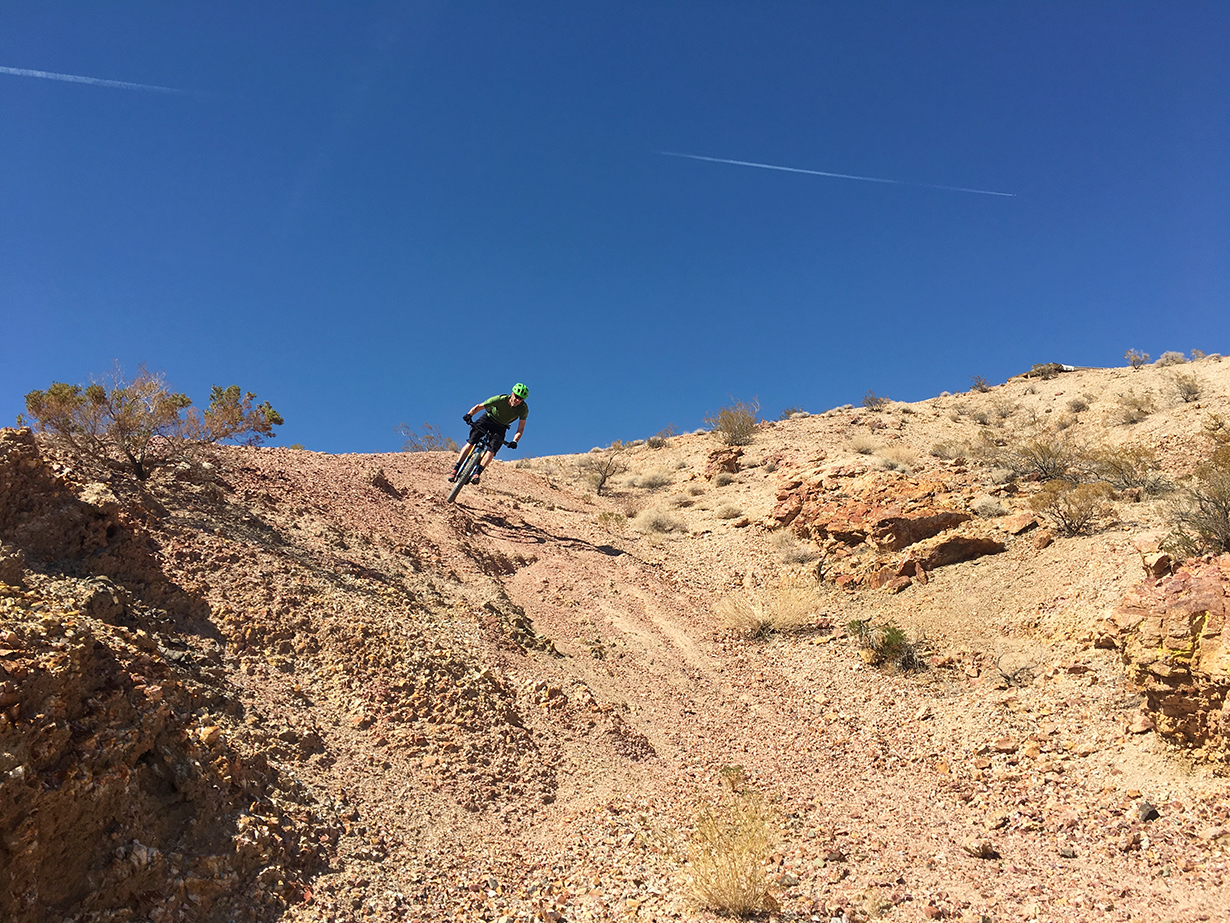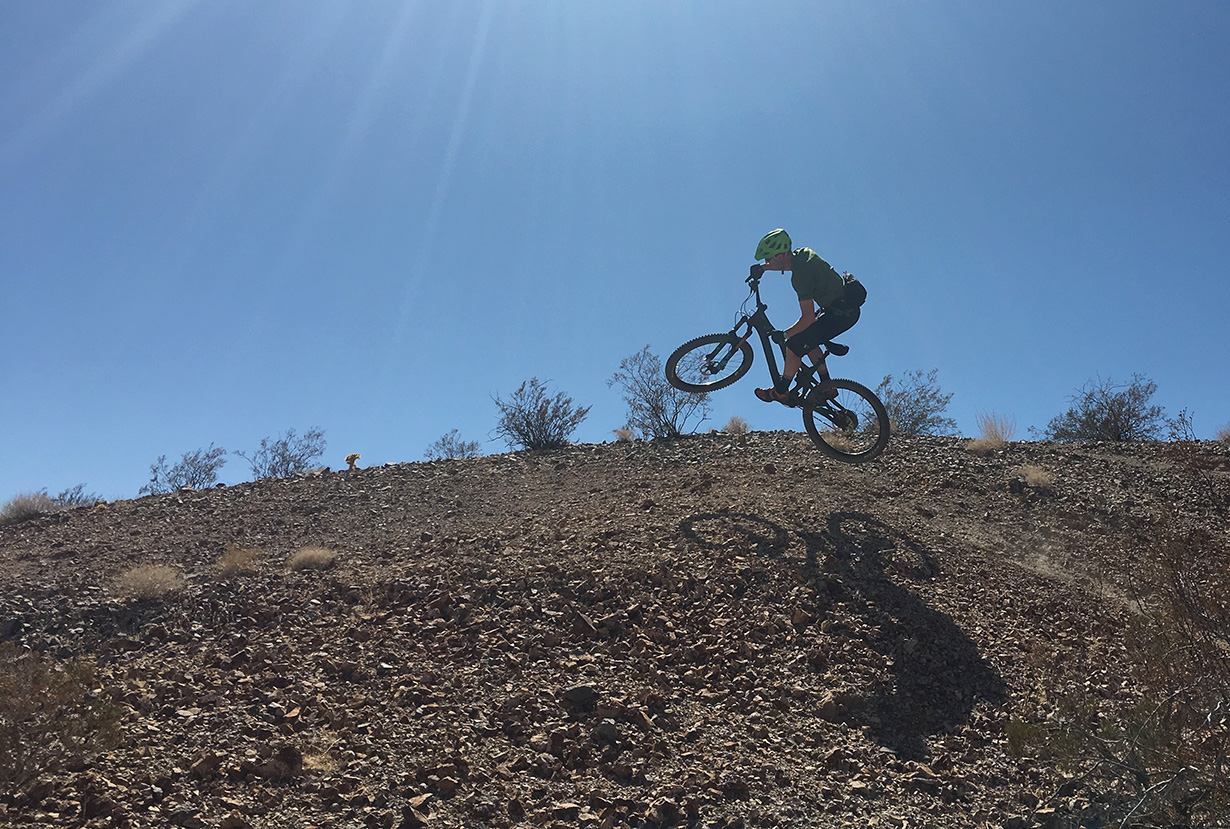2018 Pivot Mach 5.5
Size Tested: Large
Geometry: (Here)
Build Overview:
- Drivetrain: Shimano XT/XTR
- Brakes: Shimano XT
- Fork: Fox 36 Factory
- Rear Shock: Fox Float Factory DPS Evol
Wheels: 27.5′′
Travel: 140 mm rear / 160 mm front
Blister’s Measured Weight: 29.2 lbs (13.24 kg) without pedals
Reviewer: 5’9”, 155 lbs.
Test Location: Boulder City, Nevada
MSRP: $6,199.00

Caveat
Interbike’s Outdoor Demo is located at Bootleg Canyon, in Boulder City, Nevada, which is a little bastion of awesomeness about 25 minutes from the Vegas strip. There’s a mix of fast & flowy and legitimately techy terrain that makes for a pretty decent venue for a demo.
Normally, Blister tries to get as much time on a bike as possible so that we have time to play around with setup, get comfortable with the fit, and hopefully reveal any durability issues that might arise. So for obvious reasons, spending an hour or so on a bike at Interbike’s Outdoor Demo doesn’t give us the time to give a bike our usual treatment.
That said, there’s a lot of value in riding a bunch of different bikes back-to-back on the same trails. Traits that might not be obvious when the bikes are ridden weeks or months apart become evident.
So in other words, back-to-back comparisons on great trails are useful, but don’t take this as the final word on these bikes — especially when it comes to maintenance and durability issues.
So with all that said, let’s take a look at the Pivot Mach 5.5:
Intro
The Mach 5.5 was one of the bikes I was most interested to get on at Interbike this past year because it seems like a bike that hits a nice middle ground — capable enough to handle steeper, rougher trails, but not so much bike that it’s complete overkill on mellower rides. And for precisely that reason, it is these types of bikes that tend to be really popular.
So is the Mach 5.5 a contender in the highly-competitive “does-everything-pretty-well” one-bike quiver category?
The initial signs point to yes…
The Build
The Mach 5.5 that I rode was built up with Pivot’s Pro XT / XTR 1x kit, which is mostly an XT build but with an XTR rear derailleur added in. The Shimano XT kit has a well-deserved reputation for bang for the buck, and that’s no different in this case. Shifting was smooth, and the XT brakes are always solid performers.
On all Mach 5.5 builds (and indeed, most other Pivot bikes as well), Fox handles the suspension duties. The Mach 5.5 I rode had a Fox 36 Factory fork set at 160 mm travel up front, and a Float Factory DPS Evol rear shock. I’m a fan of the current crop of Fox suspension, and the offerings on the Mach 5.5 didn’t change that opinion — both the fork and the shock were smooth and supple over small bumps, but supportive when they needed to be.
There’s enough room on the Mach 5.5 that you could fit a piggyback shock if you wanted, although depending on the shock and the frame size, you might run into some clearance issues with a water bottle.
The wheels on this build of the Mach 5.5 are DT Swiss M1700’s, with a 35 mm rim. These are solid hoops, and I’ve spent a decent amount of time on various iterations of this wheelset. While they’re not completely indestructible, they generally hold up pretty well.

I do, however, have a slight gripe about the choice to go with a 35 mm rim. The Mach 5.5 is designed to work with tires up to 2.6” wide (2.6’s being the flavor of the moment in the tire world), and the stock Mach 5.5 comes with a Maxxis DHF 2.6” in the front and a Rekon 2.6” in the rear — both solid tires choices, particularly for that size. The problem I have is that, while the stock 35 mm rims are perfect for the stock 2.6” tires, the rims are too wide to bump down to a substantially narrower tire. I find that a 2.4” tire is about the minimum that works on a rim that wide, and even some 2.4” tires (like a Maxxis DHRII) are a bit too narrow to work well on a 35 mm rim.
And while some of this comes down to preferences with regard to tire width, it does limit the versatility of the bike. Personally, I’d prefer to run the Mach 5.5 with a 2.3” tire in the back and a 2.4” or 2.5” in the front (I’ll get into the reasoning behind that below). And in terms of the tires, that’s an easy and relatively affordable swap. But the wide stock rims mean that swap wouldn’t work very well, and swapping out the wheels is an expensive proposition.
So, long story short, I wish Pivot would either offer a build kit with narrower rims and tires, or spec the bike with some ~30 mm rims that’d still work with the 2.6” tires, but would also work better with narrower options if someone wanted to swap out in the future.
Fit and Geometry
Pivot has been going through a “freshening” of sorts. For a year or so, there’s been a very clear delineation between their older bikes and their newer bikes. Models that have been in the lineup for a while are decidedly short in the top tube and reach departments while newer bikes like the Switchblade and Firebird are a good bit longer. The Mach 5.5, being a new bike, follows that new bike trend.
Reach on the Mach 5.5 comes in at 439.9 mm for a Medium, and 460 mm for the Large I rode. The effective top tube length is pretty long, even by modern standards — 416.7 mm on the Medium and 639.3 mm on the Large.
At the back of the bike, 430 mm chainstays are fairly average for a bike like this — long enough to lend some stability and keep the rider in the middle of the bike, but not so long as to make the bike un-playful.
At 73.5°, the effective seat tube angle on the Mach 5.5 isn’t as steep as some of the ultra-progressive bikes on the market, but I didn’t feel like I was perched way off the back of the bike with the seat at full extension, so I’d guess the actual seat tube angle isn’t excessively slack.

The head angle comes in at 66.5° on the Mach 5.5, which would probably be considered middle of the road, or even slightly on the steep side of things these days. But, while it’s not the slackest bike out there, the Mach 5.5 doesn’t feel unstable, presumably in part due to its decently long wheelbase (1176.5 mm in a Medium).
In terms of fit, the Mach 5.5 feels like a modern bike — it’s a bit more stretched out than bikes from a few years back. Riders that are looking for a smaller, more manageable bike might consider sizing down. But for riders that are used to (or at least eager to try) a bike with modern geometry, the Mach 5.5 should feel pretty comfortable. For reference, I’d probably recommend a size Medium for riders that are around 5’ 8” to 5’ 11” or so. And of course, that can be scaled up or down depending on your individual preferences regarding sizing.
And if all of those numbers are a bit confusing, take a spin through our Bike Fit and Geometry 101 Parts 1 and 2.
The Ride
Of the newer Pivot bikes, I’m 1 for 2 on instantly liking them. I thought the Firebird was fantastic, albeit in a package that’s really only appropriate when speeds pick up. The Switchblade, on the other hand, seemed like it had potential, but I didn’t instantly fall in love with it on my short test ride.
With the Mach 5.5, I’m now 2 for 3 — I liked it right off the bat. It’s just a really easy bike to get along with.
Like all of the newer crop of Pivots (and even most of the older ones), the frame feels impressively stout. The sand and gravel of Bootleg isn’t the best place for assessing a frame’s stiffness on the trail, but I wasn’t getting much, if any, flex out of the Mach 5.5.
The suspension is supple over small bumps and smooths out the trail nicely, but it doesn’t wallow into its travel or feel like it bogs down in corners. The Mach 5.5’s suspension is moderately progressive, which is to say that I definitely bottomed it out on bigger hits, but it didn’t feel like it was getting overwhelmed — it was just using all of its travel in situations where I’d expect to use all of the travel. And on medium-sized hits (which are arguably what matter the most in terms of suspension performance) the Mach 5.5 did well. It took care of them without any noteworthy hang-ups or fuss.

As a bike situated in the “does-everything-pretty-well” class, the Mach 5.5 resides between some shorter-travel bikes that emphasize whippiness and playfulness (the Transition Scout and Santa Cruz 5010 come to mind), and some slightly longer-travel bikes that are more about business and trucking through rough stuff at high speeds (the Trek Remedy comes to mind). And I’d say the Mach 5.5 doesn’t err too sharply in either direction — it’s pretty much smack in the middle here. It’s not a glued-to-the-ground plow bike, but it’s also not an ultra poppy play bike. It can plow alright, and it can pop pretty well, but it sacrifices a bit on the ends of the spectrum to fill a broader gap in the middle.
In terms of stability, the Mach 5.5 again hits a nice middle ground. It’s not the slackest bike out there in this travel class, so it feels a bit more maneuverable in slower, tighter situations. But it’s slack enough, and maybe more importantly, long enough that it doesn’t feel squirrely on faster descents. I rode one fairly high-speed ridgeline at Bootleg that had the unique technical feature of a 30 mph crosswind, and the Mach 5.5 felt stable and planted even as I was getting blown sideways. Kind of an odd test of a bike’s stability, but I think it was actually a decent indicator.
When the trail points back uphill, the Mach 5.5 does well — true to it’s “does-everything-pretty-well” roots, the Mach 5.5 isn’t a chore on climbs. It maintains a nice blend of efficiency on smooth climbs while still being just active enough to maintain traction pretty well on loose, steep climbs.

2.6″ Tires
So let’s talk about the tires — as I noted above, the stock 2.6” tires would not, personally, be my choice for this bike. I’ll admit that this was my first outing on the new “plus-minus / plus-curious” tire size, and my initial impression is that they feel closer to a 2.8” plus tire than a “normal” 2.5” tire. And that’s not necessarily a bad thing, but I’m not totally sold on the 2.6’s for the same reasons I’m not totally sold on the bigger plus sizes.
The 2.6’s feel a bit imprecise, they noticeably roll over when pushed hard into corners, and while they offer up a lot of traction in some situations, they actually offer less traction in others. Without turning this into a tire review, I like them in sandy situations, but in loamier dirt I prefer a narrower tire that cuts in and hooks up as opposed to a wider tire that floats over the top and struggles to find purchase in the looser dirt. Think of it like a snow tire on a car — snow tires are generally narrower so they can cut through the fluff and find grip on the underlying surface.
All that said, I can certainly see why some people get along with the 2.6’s. They smooth out the trail, and in many situations, they offer a bit of extra confidence and traction, which is a good thing. My point, with respect to the Mach 5.5, is mostly that I think Pivot’s choice of rim width is unfortunate, since it limits the ability to swap to a narrower tire for those that might prefer such a thing.
Bottom Line
Putting my personal tire preferences aside, the Pivot Mach 5.5 is a successful one-bike quiver. It’s light and efficient enough that it’s not unreasonable to take it on longer adventures that involve a lot of pedaling, but it has a stiff frame and geometry that are fairly willing to slap berms and get a bit sendy when the need arises.
If you’re only looking for a bike for huge adventures, there are some shorter-travel rigs that would probably work better. And if you’re looking for a bike primarily for riding super rough descents and shuttle laps, there are bikes that do that better, too. But if you want one bike that does a pretty decent job for both of those things, the Mach 5.5 should be high on the list.
For some comparisons to other bikes in this class, check out our Guide and Comparisons of 27.5” Trail Bikes.

My thought about 2.6 tires is they’re ok on the front. Rear I would rather have a 2.3-2.4 (depending of course on the honesty of width…)
Would you say this makes sense with them? That the tire roll of the wider tire is more noticeable in the back like I’ve found? Also here in the PNW we have less climbs where we are searching for traction uphill on the rear tire, so maybe this makes sense here. But downhill more bite in the front is often nice.
Yeah, definitely. I guess the question of whether to go with a wider front tire (vs. both tires of the same width) is mostly a matter of preference and riding style, but I think a 2.6″ front paired with a 2.4″ or 2.5″ rear would make a lot of sense.
Will you be doing any reviews of the Rocky Mountain Slayer or Altitude in the coming months?
We’re working on getting our hands on an Altitude – we’re pretty interested to see how the new revisions changed the bike!
Great review thanks.
I was a long time fan of the 5.7 but went for transition Scout this Spring in the absence of anything from Pivot.
About a month after falling in love with the scout the 5.5 came out.. I’d relish a chance to test ride the 5.5 but it would be hard the beat the scout for fun, playfulness and all round hot-hatch of trail bikes.
How does it compare to the Troy?
Would the Ibis Mojo 3 be in the same category, and how do they compare?
I think the review is pretty spot on. I have a 5.5 xo1 with some We Are One carbon wheels with 240’s hubs. They are a 27 internal. Didn’t work well with the 2.6 WT but ride well with smaller rubber and save a good deal of weight over the stock 35 mm internals. I am riding a DHF 2.5 up front and a DHR2 2.4 in the back and it’s a good combo for the wheels and Tahoe area, feels like a different bike. Steering seems more direct and less floaty. The Rekon is fine in the wet and would probably be find in AZ, Utah and other areas but I didn’t like it on loose over hard dirt. I think it doesn’t everything pretty much sums it up. I have a gen1 Yeti 5c and the Yeti climbs much much much better and is very capable. The 5.5 is more burly and more stiff (in a good way) it’s want to be pushed harder going down and I look for stuff to hit instead of the cleaner line on the Yeti. On longer rides I am faster on the Yeti but at the end of the day I have more fun on the chuck, jumps and more aggressive trails on the 5.5. For all day adventures it works but has some compromises, for 4 hours or shorter it’s a great 1 bike quiver and can still tackle most everything. It likes slow to medium speed technical trails but doesn’t love full speed runs, it does lose some stability pointed straight down. It’s a very good bike.